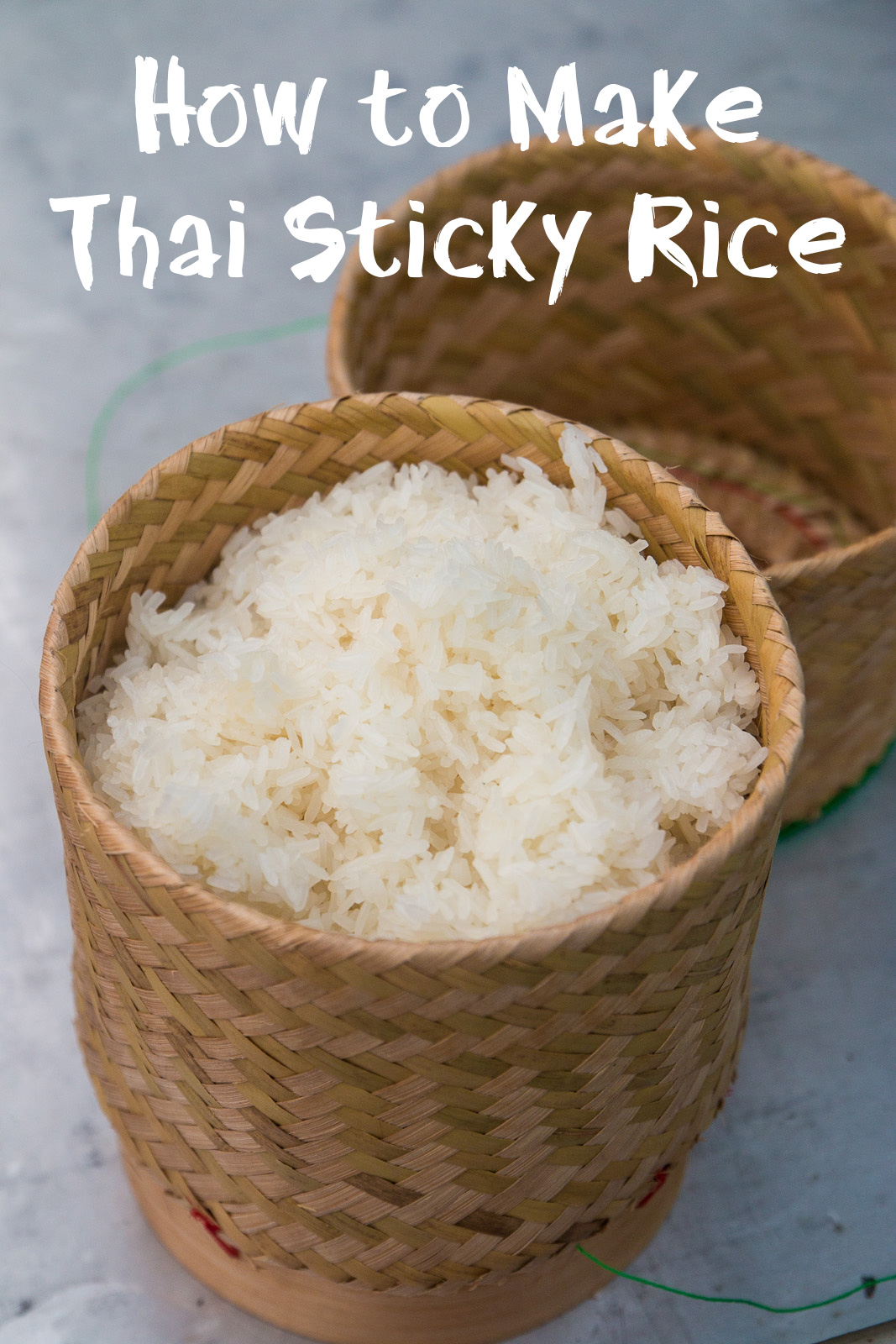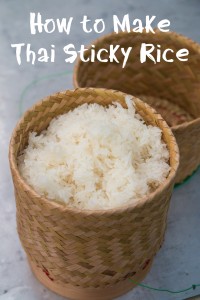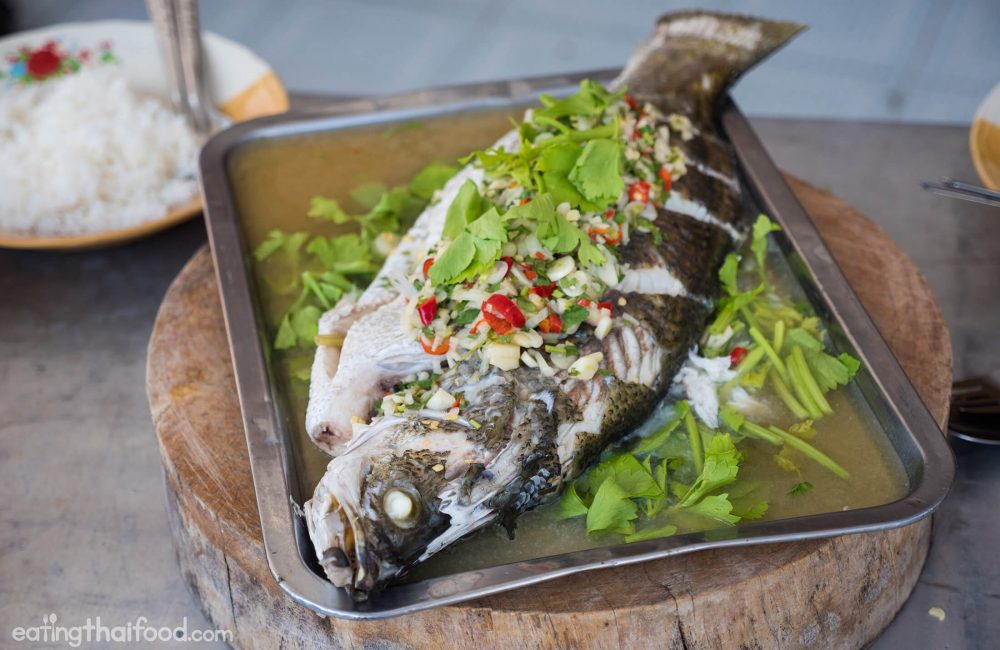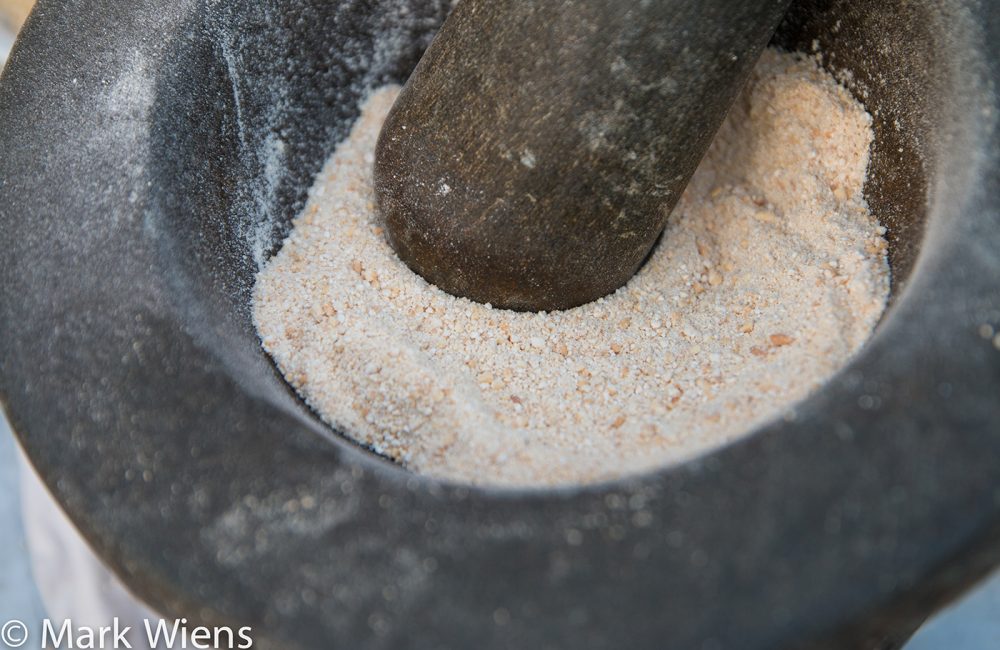How to Make Thai Sticky Rice (and How To Eat It)

We’re about to learn how to make Thai sticky rice.
But first let me first tell you a story…
Before I ever came to Thailand when I was in university, I sometimes went to a Thai restaurant in the US, and I would order green curry along with Thai sticky rice.
I can’t remember exactly how I would eat it, but I think I would just take some of the green curry, put it onto my sticky rice, and eat it off my plate using a fork.
Fast forward 10 years, after living in Thailand for years now, and learning so much about the food, I sometimes look back on that story, and I have to chuckle at myself.
Why?
Because in Thailand, eating green curry with sticky rice, just doesn’t go together; Most Thais would not even think of eating that combination.

How to make awesome Thai sticky rice!
Green curry is eaten with regular steamed rice. The reason is, green curry originates from the central region of Thailand, where regular rice is the staple.
Sticky rice originates from the northern and northeastern regions of Thailand, and green curry is not part of the local food culture.
NOTE: I’m by all means not saying it’s bad to eat green curry and sticky rice, and if you like to do it, go for it (I like it too). But I’m just using this as an example so we can learn about the culture of eating sticky rice in Thailand.

This is often how you’ll get sticky rice at a restaurant in Thailand
Now let’s move into sticky rice…
Sticky rice is likely something you think about when you think about Thai food.
And there’s a good reason for that, sticky rice is one of the major staples of Thai cuisine… that is, in certain regions of Thailand (we’ll go over that in detail in this post).
Sticky rice in Thailand is eaten as a staple starch – the main filler of a meal, it’s also eaten as a snack along with something salty like grilled meat, and it’s also an important ingredient in many Thai desserts.
In this post, I’m not only going to explain to you how to make Thai sticky rice, but I’m also going to offer a bit of information about the culture of eating sticky rice and how it’s eaten in Thailand.

What is sticky rice?
First, what is sticky rice?
In Thai, sticky rice is called khao neow (ข้าวเหนียว), which literally means rice sticky.
Sticky rice is a type of rice that is extremely sticky – in fact when you pick it up with your fingers, it will stick to your fingers.
The grains are glutinous, like tiny little gummy worms (it’s not sweet of course, but that’s closest texture I can think of).
But why is it so sticky?
This article by The Kitchn explains that all rice is made up of two different parts of starch components: amylose and amylopectin. Now, I don’t really begin to know what each really is, but sticky rice contains almost zero amylose and all amylopectin, and that’s the reason it’s sticky.
When you look at raw sticky rice, it looks almost the same as normal long grain rice, but you’ll notice the color is whiter and milky – it’s not transparent at all.
In Thailand, sticky rice is considered a serious energy food. And many people often think that if you’re feeling sleepy or need a nap, you may have eaten too much sticky rice (this is a joke, but I have heard many Thais use it)!
But there is a point to it – Thai sticky rice is higher in calories and takes longer to digest than regular rice. That’s one of the reasons why eating sticky rice is so common for farmers and laborers in Thailand – to have lasting energy.
That energy can either be used to burn as you work, or if you don’t have any work, it just makes you sleepy.
I’m here to tell you, if you eat a bunch of sticky rice, you may feel the need to take a nap!

The sticky rice region of Thailand
Where is sticky rice eaten?

Steaming sticky rice in Isaan
While Thailand is famous for eating sticky rice, where exactly is it the main staple in people’s diets?
The answer is mostly in both the northeastern (the region referred to as Isan or Isaan) and the northern regions of Thailand.
Also, I just wanted to mention that these regions of Thailand are very similar to many parts of the country of Laos (where the majority of the country consumes sticky rice), and share many cultural and culinary parallels.
Throughout Isaan and the northern parts of Thailand, sticky rice is grown and consumed daily. For many, a meal is not complete without eating sticky rice.
When you are traveling or visiting Isaan or the north of Thailand, you’ll have the opportunity to eat sticky rice for breakfast, lunch, dinner, and for snacks as well.
In Bangkok, sticky rice is available nearly everywhere you look, especially since the city is made up of a massive population of residents originating from northern and northeastern parts of Thailand. You’ll find sticky rice at all Isaan restaurant throughout Bangkok, as well as at food stalls that serve grilled meat or moo ping (skewers of grilled pork).
In the south of Thailand, and traditionally in much of the central parts of Thailand, regular white steamed rice, is the standard staple, not sticky rice. However, you’ll still find Isaan restaurants throughout all of Thailand, and you’ll find sticky rice at all Isaan restaurants. Additionally, in the south of Thailand, as well as in other regions, sticky rice is commonly used in sweet desserts, but not as the staple.

A meal in a village in Isaan near Khon Kaen
Culture of eating sticky rice
According to the Smithsonian, sticky rice has been grown in Southeast Asia for over 4,000 years.
4,000 years of being in-grained into Isaan and northern Thailand, and you can imagine how sticky rice is not only a part of meals, but it’s a major part of culture.
Sticky rice is what many people grow and eat and socialize around.
In Thailand, families often live together – grandparents, parents, kids, babies – and this holds especially true in the more traditional countryside of Thailand, as opposed to the more modern cities. Meals are eaten family style.
Sticky rice is usually steamed in the early morning, then stuffed into a specific sticky rice basket called a kradib khao neow (กระติ๊บข้าวเหนียว), and the same batch is eaten throughout the day.
The basket is made from thin slivers of bamboo, all weaved together in a tight cylinder basket with a lid. It’s typically a communal family basket, and so enough sticky rice is made for everyone in the family.
A kradib khao neow (กระติ๊บข้าวเหนียว) keeps the rice from getting hard and crusty on the edges, and though it eventually does cool off, it remains soft and fluffy throughout the day.
When meal times roll around, or even snacks, the big basket of communal sticky rice is placed in the center, and all eaters grab a handful and consume it with the side dishes.

A northern Thai meal I bought at the market – sticky rice in banana leaf
Sticky is eaten with fingers. To eat, you normally take a sticky ball of grains about the size of an olive, and form it into a small ball shape with your fingers.
You can then either eat it straight, or proceed to dip it into the sauce of one of the side dishes.
Depending on what dish you dip your sticky rice into, it will probably be something with a little spice and lime juice from the dish, to give each bite of your sticky rice flavor.
Although you’ll find the big sized kradib khao neow (กระติ๊บข้าวเหนียว) in the countryside in Thailand, in cities and at restaurants you’ll often be served individual portions of sticky rice in small sticky rice baskets, but the same eating method applies.
Also, on the streets or at local markets, vendors normally dish out sticky rice in plastic bags or in banana leaf wrappers.

Grilled chicken and sticky rice – yes please!
What food do I eat sticky rice with?
Going back to the story I shared with you at the beginning, while sticky rice is available all over Thailand, it’s not necessarily eaten with all Thai food.
The food eaten with Thai sticky rice correlates and is characterized by region and geographical location of Thailand.

Som tam (ส้มตำ) – green papaya salad is always eaten with sticky rice
Foods eaten with sticky rice:
- Almost all Isaan food and northern Thai food
- All types of green papaya salad (som tam ส้มตำ)
- Meats salads like koi khua neua (ก้อยคั่วเนื้อ) and laab (also spelled larb ลาบ)
- Lots of grilled meat like grilled fish, grilled pork, and aeb (grilled meat or fish in a banana leaf)
Foods not typically eaten with sticky rice:
- Stir fried dishes – like pad kra pao or other stir fried dishes
- Many of the Thai curries, including most coconut milk based curries
- Soups like tom yum or tom kha
Again, if you want to eat sticky rice with any Thai dish, I think that’s alright, and I would go for it. But I just want to cover the traditions of Thailand and Thai culture.

How to make Thai sticky rice (วิธีทำ ข้าวเหนียว)
How to make sticky rice
Ok, now that we’ve covered quite a lot of information on what sticky rice is and how it’s eaten in Thailand, we are ready to dive into the sticky rice recipe.
Soak the sticky rice overnight
In sticky rice eating regions of Thailand, the rice is usually soaked in water overnight, and for this recipe that’s exactly what I’ll be doing.
If you don’t soak it overnight, make sure you soak it at least for 4 – 5 hours.
There are some recipes that say you can skip the soaking and just steam for 1 – 2 hours or something like that, but I think for the greatest results, it’s best to stick with the traditional Thai and Laos method of soaking the rice overnight.
To soak the rice, you don’t need to rinse it, just add the amount of rice you want to cook into a plastic tub or metal bowl, submerge it in water, and let it sit.
When it comes time to cook, I like to just grab the rice out of the water with my hands, strain, and the water left behind should be milky from the starch.
Steaming

Cooking Thai sticky rice in Isaan
In Thailand, sticky rice is steamed in a basket made from bamboo called a teeneung khao neow (ที่นึ่งข้าวเหนียว).
The basket is the shape of a big cone, closed off at one end, and open and wide at the top.
The sticky rice is added to the bottom of basket, placed over a pot of water, and steamed. The weave of the basket allows hot steam to rise, cooking the rice evenly and beautifully.
Now, you don’t need all this equipment to make sticky rice, but it is helpful. Alternatively you could also come up with your own type of steaming mechanism, like a cloth or mesh that somehow is raised above a pot of water. Just make sure the rice is above the water, not touching it.
When I was in the US, I went to an Asian supermarket, and I was happy to see they had bamboo sticky rice steamer baskets available, so you might check an Asian supermarket if you want to buy one.
Amount of rice
For this recipe, I used 1 kg. of Thai sticky rice, which is quite a good sized portion – I think it could feed about 4 hungry people for a full meal, maybe more.
But really, the amount of sticky rice I made doesn’t really matter, the recipe will still be the exact same for one cup or ten cups.
If you have a few minutes, definitely press play to watch the video below. It will explain exactly how to make sticky rice, right from my Thai street food cart!
(If you can’t see the video, watch it here)
Sticky rice recipe (วิธีทำ ข้าวเหนียว)
Time: Overnight soaking (or for 4 – 5 hour minimum), about 15 minutes to steam
Recipe size: I used 1 kg. of Thai sticky rice, which is probably enough for 4 – 6 people for a meal
Cooking utensils: pot, sticky rice steamer basket
Flavors: Fluffy Thai sticky rice
Eat it with: Isaan and northern Thai cuisine

- water to soak rice
- 1 kg. sticky rice (or however much you want to make)
- The night before you want to cook sticky rice, take your raw sticky rice, place it into a bowl or plastic tub, submerge in water, and allow to soak room temperature overnight. Alternatively, you can soak for at least 4 - 5 hours, but overnight is best.
- Take the sticky rice out of the water (and the grains should be softer and a little swollen), and place into a bamboo steamer, or any type of steamer. Cover the steamer with either a lid, or you can do what I did and cover the basket with a cloth, then a metal lid - just to keep all the steam within the rice.
- Add water to a pot with the steamer over the pot (just make sure the water doesn’t touch the sticky rice), and once the water comes to a boil, steam for 15 - 20 minutes (usually 15 minutes for me is perfect) on a medium heat.
- After 15 minutes take off the lid carefully, because it will be very hot, and just grab a taste test of the sticky rice to make sure it’s soft and fluffy. If it’s still a little crunchy, steam for a few more minutes, but if it’s good to go, turn off the heat and either eat immediately, or transfer to some sort of airtight container or basket to hold until you’re ready to eat.
- Enjoy Thai sticky rice while it's hot and fresh.

Northern Thai style basket for sticky rice
Conclusion
Thai sticky rice (khao neow ข้าวเหนียว) is the most important staple of Thai cuisine in the northeastern and northern regions of Thailand.
In this recipe you’ll learn how to make Thai sticky rice so it turns out delicious and fluffy, and also how it’s cooked and eaten in Thailand.
Sticky rice makes a wonderful complement to so many Isaan and northern Thai dishes.
I hope you enjoyed this recipe, and I would be thrilled if you would leave a comment below, and share this recipe with someone you know who loves Thai food as well.
Also, be sure to check out all of my Thai recipes here, for many more delicious dishes.


